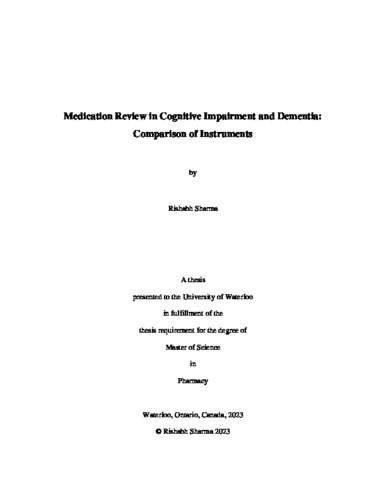| dc.description.abstract | Background: - Cognitive impairment (CI) and dementia are significant concerns in older adults in Canada. Drug-related problems (DRPs) are common and can cause up to 30% of hospitalizations in older individuals, including adverse drug reactions, drug interactions, potentially inappropriate medication (PIM) use, and medication adherence. Prescribing in older patients with multiple morbidities, especially with dementia, is a complex process that demands regular review of medications to provide quality care to dementia patients.
Objective: - The primary objective was to compare the mean number of DRPs using the Medication Review in Cognitive Impairment and Dementia (MedRevCiD) Checklist to the Medication Appropriateness Index (MAI) criteria in older adults with CI and/or dementia. The secondary objective was to identify which explicit tool, Beers Criteria 2023, or the Screening Tool of Older People Potentially Inappropriate Prescriptions (STOPP) Criteria 2023, identified more PIM use among older adults with CI or dementia.
Methods: - A cross-sectional study was carried out with older adults receiving care for CI or dementia. Forty-four patients from the Multi-specialty Interprofessional Team-based (MINT) memory clinic were recruited to participate in the study. The researcher employed two distinct tools, namely the MAI and the MedRevCiD Checklist, to conduct a medication review. PIMs were identified utilizing the Beers Criteria 2023 and the STOPP Criteria 2023. The Wilcoxon signed-rank test was used to assess whether there is a significant difference in the mean number of DRPs identified by the MedRevCiD versus MAI. Bivariate logistic regression analysis was employed to identify potential factors associated with DRP and PIM use.
Results: - A total of 134 DRPs were identified in 44 patients per the MedRevCiD checklist. The average number of DRPs identified was 3.05, with a standard deviation (SD) of 4.0 DRPs per person. Notably, over half of the DRPs (53%, n= 71) identified fell into domain 6 of the MedRevCiD checklist (optimizing medication use). In comparison, 81 DRPs were identified in 44 patients per MAI criteria (mean: 1.84 per person, SD 2.9) DRPs per person. The majority of the DRPs identified using MAI criteria (44.4%, n= 36) were from clinically significant drug-disease/condition interactions. There was a significant difference in the mean number of DRPs between the two instruments (Z= -4.735, p-value <0.001). In this study, at least one PIM was used by 47.7% (n= 21) and 27.2% (n= 12) of participants based on Beers and STOPP criteria, respectively. Binary logistic regression revealed a statistically significant association between the number of comorbidities (P= 0.002), number of medications per day (P= 0.032) with DRP use as per MAI criteria. For each additional comorbidity, there was 1.86 times higher odds of experiencing DRPs and 1.20 times higher odds of having DRPs according to MAI criteria. Individuals with nine or more comorbidities had 8.4 times higher odds of being prescribed PIMs (p = 0.027, 95% confidence interval (CI): 1.27 – 55.39); given the wide range of the confidence interval it is essential to note that there was considerable uncertainty about the strength of the association.
Discussion: - The findings of this study provided insights into the higher prevalence of DRPs among older adults with CI or dementia. The MedRevCiD Checklist emerged as a valuable tool, demonstrating a heightened ability to uncover DRPs in this population. This underscores the importance of utilizing tools tailored to the unique needs of individuals with dementia when assessing DRPs. Furthermore, identifying PIMs using Beers and STOPP criteria highlights the significance of addressing PIMs in this demographic. This study adds valuable insights to the progressing comprehension of medication complexities in older adults facing CI and/or dementia. | en |

